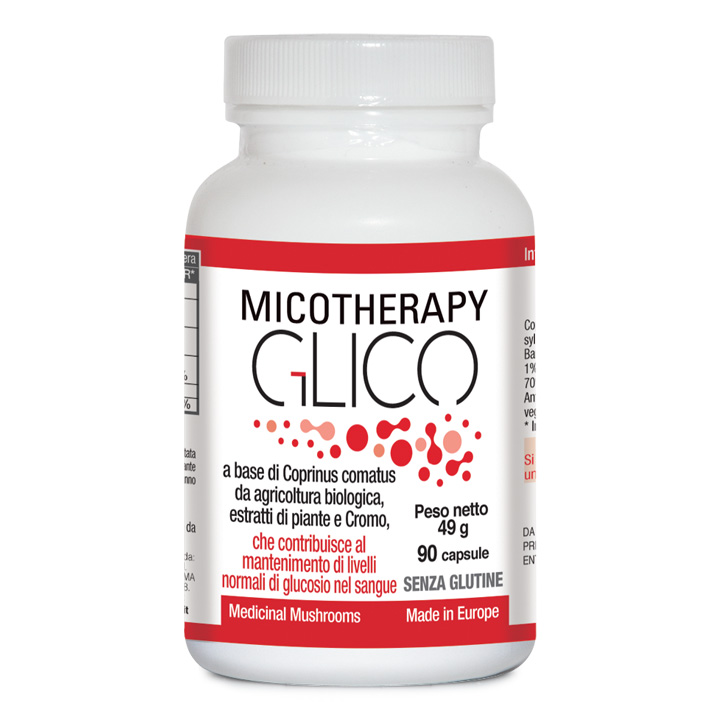
Support of sugar metabolism
Food supplement containing organically-grown Coprinus comatus, plant extracts and Chromium.
Health benefits:
Micotherapy Glico containing Coprinus comatus is a formulation designed to support carbohydrate metabolism and therefore helps to maintain normal blood glucose levels.
Properties:
Commonly known as ‘Shaggy mane’ in America and as ‘Ink mushroom’ in Italy, Coprinus comatus is a mushroom that promotes blood glucose reduction and is very useful as a support in conditions of impaired blood glucose control.
Ingredients:
- Coprinus whole mushroom
- Gymnema dry extract (titrated at 75% in gymnemic acid)
- Banaba dry extract (titrated at 1% in corosolic acid)
- Rose hip dry extract tit. in vit. C (titrated at 70% in Vit. C)
- Methylsulfonylmethane (MSM)
- Chromium picolinate
Properties of the ingredients:
- Gymnema: educes sugar absorption by up to 50%. It improves intracellular glucose metabolism and promotes blood glucose control.
- Banaba: improves the use of glucose by the cells, which helps to reduce blood sugar levels and also fat in the liver.
- Rose hip: is one of the richest natural sources of vitamin C. It boosts the body’s defences against infection and is particularly important in situations of impaired blood sugar control.
- Methylsulfonylmethane (MSM): a source of bioavailable sulphur. Sulphur is an important component of the glutathione molecule.
- Chromium picolinate: promotes the anabolic action of insulin and muscle anabolism. It boosts lipid and carbohydrate metabolism and helps regulate blood glucose levels. It reduces the sense of hunger and the craving for sweet foods.
Directions:
1 capsule three times per day, one hour before meals
Pack:
pack containing 90 capsules
vegetable cellulose capsules
Notes:
Gluten free
Made in Europe
No GMO
| AVERAGE CONTENT OF CHARACTERISING INGREDIENTS | PER DAILY DOSE (2 CAPSULES) | RDA |
| Coprino sporophorum | 600 mg | |
| Gymnema dry extract | 300 mg | |
| Acid content | 225 mg | |
| Banaba dry extract | 300 mg | |
| Corosolic acid content | 3 mg | |
| Rosehip dry extract | 90 mg | |
| Vitamin C content | 63 mg | 78 % |
| Methylsulfonylmethane (MSM) | 30 mg | |
| Chromium | 200 mcg | 500% |
BIBLIOGRAPHY:
- CHan, JYuan,YWang,andLLi. Hypoglycemic activity of fermented mushroom of Coprinus comatus rich in vanadium. J Trace Elem Med Biol, Jan 2006; 20(3): 191-6
- Yingtao Lv, Linna Han, Chao Yuan, and Jianyou Guo. Comparison of Hypoglycemic Activity of Trace Elements Absorbed in Fermented Mushroom of Coprinus comatus. Biol Trace Elem Res, Mar 2009Abstrac
- C Han, B Cui, and Y Wang. Vanadium uptake by biomass of Coprinus comatus and their effect on hyperglycemic mice. Biol Trace Elem Res, Jul 2008; 124(1): 35-9
- G. Zhou and C Han. The co-effect of vanadium and fermented mushroom of Coprinus comatus on glycaemic metabolism. Biol Trace Elem Res, Jul 2008; 124(1): 20-7
- Sugihara, Y; Nojima, H; Matsuda, H; Murakami, T; Yoshikawa, M; Kimura, I (2000). “Antihyperglycemic effects of gymnemic acid IV, a compound derived from Gymnema sylvestre leaves in streptozotocin-diabetic mice”. Journal of Asian natural products research 2 (4): 321–
- Shanmugasundaram KR; Panneerselvam C; Sumudram P; Shanmugasundaram ERB (1981). “Insulinotropic activity of G. sylvestre, R.Br. and Indian medicinal herb used in controlling diabetes mellitus”. Pharmacol Res Commun 13 (5): 475–48
- Asare-Anane, H; Huang, GC; Amiel, SA; Jones, PM; Persaud, SJ (2005). “Stimulation of insulin secretion by an aqueous extract of Gymnema sylvestre: role of intracellular calcium”. Endocrine Abstracts 10: DP
- Persaud SJ; Al-Majed H; Raman A; Jones PM (1999). “Gymnema sylvestre stimulates insulin release in vitro by increased membrane permeability”. J Endocrinol 163 (2): 207–21
- Gholap S; Kar A (2003). “Effects of Inula racemosa root and Gymnema sylvestre leaf extracts in the regulation of corticosteroid induced diabetes mellitus: involvement of thyroid hormones”. Pharmazie 58 (6): 413–41
- Joffe DJ; Freed SH (2001). “Effect of extended release gymnema sylvestre leaf extract (Beta Fast GXR) alone or in combination with oral hypoglycemics or insulin regimens for type 1 and type 2 diabetes”. Diabetes in Control N Stohs SJ, Miller H, Kaats GR A review of the efficacy and safety of banaba (Lagerstroemia speciosa L.) and corosolic acid. Phytother Res. 2012 Mar; 26(3):317-24. Epub 2011 Nov 17
- G. N. Dakhale, H. V. Chaudhari, and M. Shrivastava, “Supplementation of vitamin C reduces blood glucose and improves glycosylated hemoglobin in type 2 diabetes mellitus: a randomized, double-blind study,” Adv Pharmacol Sci, vol. 2011, p. 195271, 201
- C. A. Krone and J. T. A. Ely, “Vitamin C and Glycohemoglobin Revisited,” Clinical Chemistry, vol. 47, no. 1, p. 148–148, Jan. 2001
- Brownlee M, Cerami A and Vlassara H. “Advanced glycosylation end products in tissue and the biochemical basis of diabetic complications.” N Engl J Med (1988) 318: pp. 1315-1321
- G.Atmaca, “Antioxidant Effects of Sulfur-Containing Amino Acids,” Yonsei Medical Journal, Vol. 45,5,776-788,2004
- A . Charlesby, et al., “Radiation Protection with Sulfur and Some Sulfur-containing Compounds,” Nature, Vol. 194, 782, May 26, 1962



